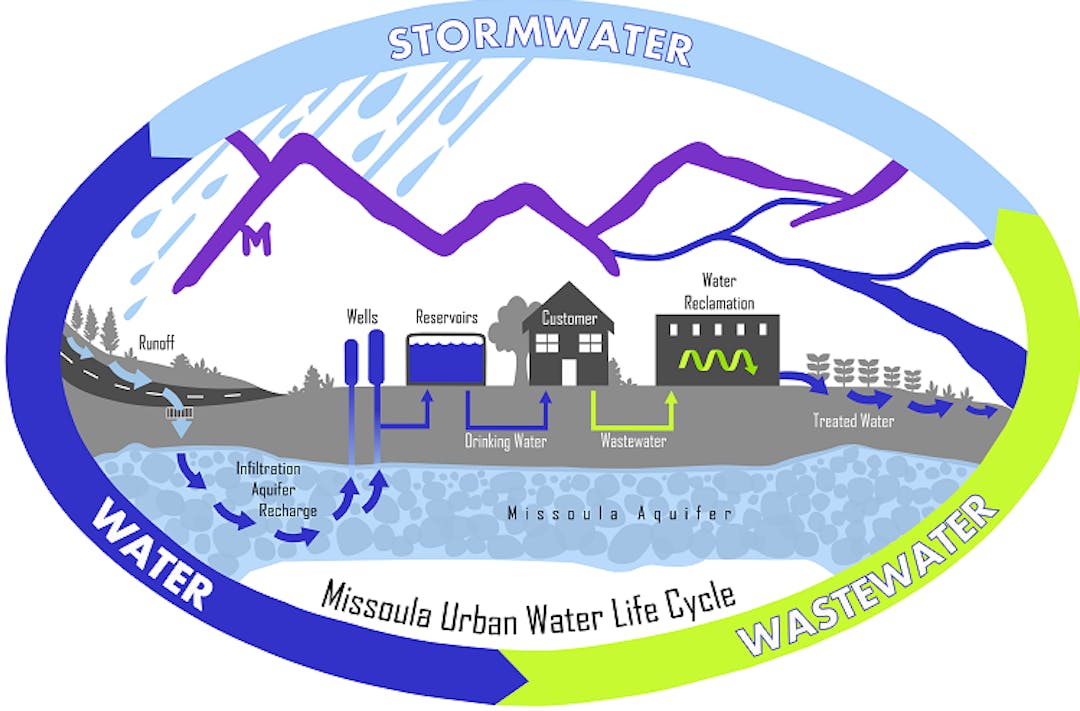Proposed Utility Rate Increases
Consultation has concluded.
City Council approved the utility rate increases on Dec. 13, 2021, as proposed by the Public Works & Mobility Department. The new rates went into effect January 1, 2022, and began appearing on utility bills in February..

Description
Missoula's Water, Wastewater, and Stormwater utilities will present proposed utility rate increases at City Council's Public Works Committee meeting on November 10, 2021, with a public hearing tentatively scheduled for December 6 (Citizen Participation Guide for both meetings). We invite utility customers to review the information on this page to learn why additional investment is needed. Please ask us questions by using the Questions tab at the bottom of this page.
UPDATE: Many questions from the public were answered during the public hearing on Dec. 6, 2021. The video for Public Works and Mobility's presentation to Council can be found at around 1:06 of video: https://www.youtube.com/watch?v=9HdQNKYvrJg. City Council approved the rate increases on Dec. 13, 2021, and the new rates went into effect January 1, 2022.
Proposal and Explanation
For less than the cost of a typical monthly bill for Internet service, Missoula’s utilities provide our customers with high quality drinking water as well as wastewater and stormwater services that protect the water bodies thousands of Missoulians recreate in every year.
Inflation
Our dedicated utility professionals strive to keep our rates as low as possible, but many cost increases—like those for power, materials, and contract bid prices—are beyond our control. We need to increase our utility rates so that we can continue to:
- provide the same level of service our customers rely on,
- keep up with state and federal regulations, and
- increase investments to improve and maintain our aging infrastructure.
Historically Low Rates
Water rates haven't changed since 2011, and wastewater rates haven't changed since 2015. In fact, when we restructured wastewater rates in 2020 to be compatible with our water billing system, wastewater revenues ended up being even lower than they were previously. So, while we continue to provide our customers with efficient, reliable service, we have fallen behind in our ability to take care of the systems as our costs go up.
Modest Request
The proposed rate increases would take effect over a three-year period to minimize the impact on our customers and allow timely investment in our utility infrastructure. The total proposed increase for 2022 would add $2.92 to the average residential customer’s total monthly bill for water, wastewater, and stormwater services. As shown in the graphs below, Missoula's utility rates for the average household will still be some of the lowest in Montana even after these proposed increases.
This proposed rate increase would be effective on January 1, 2022, with additional increases occurring in 2023 and 2024, as shown in the tables below.
2021 Combined Residential Utility Rates for Other Montana Cities and Towns
As the chart below shows, Missoula's combined monthly rates for water, wastewater, and stormwater services are nearly the lowest in Montana. (AE2S/Nexus takes annual utility rate surveys from around the region and publishes the results in the Annual Utility Rate Survey. Charts shown here are from the 2021 survey.)
Before proposed additional system investment:

After proposed additional system investment:
Even after our proposed additional investment, Missoula's 2022 combined residential utility rates will still be nearly the lowest in the state.

*Note: For comparison purposes, AE2S uses 6,000 gallons of residential water usage and wastewater flow to compare rates in different cities. Missoula's average water customer uses slightly more, which is reflected in the average monthly bills shown in the table below.
The Bottom Line
The following tables show the proposed increases for residential and commercial customers:
Residential Monthly Rates
The table below shows current average monthly residential water, wastewater, and stormwater bills as well as projected average monthly bills for the next three years.
| Current | Proposed 2022 | Proposed 2023 | Proposed 2024 | ||||
| Water | $42.10 | 3% = $1.26 | $43.36 | 5% = $2.17 | $45.53 | 5% = $2.28 | $47.81 |
| Wastewater | $15.69 | 9% = $1.41 | $17.10 | 9% = $1.54 | $18.64 | 9% = $1.68 | $20.32 |
| Stormwater | $4.21 | 6% = $0.25 | $4.46 | 9% = $0.40 | $4.86 | 9% = $0.44 | $5.30 |
| TOTAL | $62.00 | $2.92 | $64.92 | $4.11 | $69.03 | $4.39 | $73.43 |
Commercial Rates
Commercial rates have many variables, so please see the Proposed Utility Rate Schedule for more information.
| Proposed 2022 | Proposed 2023 | Proposed 2024 | |
| Water | 3% | 5% | 5% |
| Wastewater | 9% | 9% | 9% |
| Stormwater | 6% | 9% | 9% |
Click on the links below to see additional information for each utility.
Consultation has concluded.
City Council approved the utility rate increases on Dec. 13, 2021, as proposed by the Public Works & Mobility Department. The new rates went into effect January 1, 2022, and began appearing on utility bills in February..
Please ask us a question about the proposed rates.







